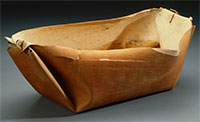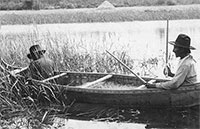Traditional Seasonal Round
The traditional seasonal round of the Ojibwe focuses on the types of fish, game and plant resources locally abundant at different times of the year. Fond du Lac band members continue to preserve and practice these traditions including harvesting wild rice and maple sugaring.
Spring
As the snow melted and the sap began to run, Ojibwe families left their winter camp for their ancestral sugar bush where they would collect and process the sap of maple trees. Fishing, first on frozen lakes and then in flowing streams, would also occur during the spring as did the hunting of muskrats for fur. The activities of this season would provide families with a supply of sugar, often packed in birch-bark containers, as well as dried fish.
Summer
During spring and summer months, Ojibwe bands would gather in large groups on the shores of lakes. Here they would plant gardens and fish, while they built canoes (which required birch bark and cedar roots), prepared hides, and wove mats of bulrush, cedar bark, and cattails. Summer was also a time for gathering available medicinal plants and picking berries. The woods of northern Minnesota contain a wide variety of berries including juneberries, gooseberries, and blueberries. Berries were dried and stored for later use.
Fall
As fall approached, Ojibwe families would go to their wild ricing grounds. The wild rice that they harvested together with the crops from the summer gardens would supply their family in the coming months. During the fall, the Ojibwe also fished for whitefish and other species.
Winter
As the lakes froze and the snow came, the Ojibwe returned to their winter campsites. These camps were located in the woods near the game. Here they constructed houses covered in bark and insulated with woven mats. Winter was a time of hunting and trapping, and the butchering and drying of meat.
Nodinen’s Narrative
About 1900, ethnographer Frances Densmore interviewed Nodinens (Little Wind), an Ojibwe woman raised at Mille Lace in the 1840s and 1850s who later resided at White Earth. This is her account of the seasonal round (White 2007:145).
When I was young everything was very systematic. We worked day and night and made the best use of the material we had . . . My home was at Mille Lac[s] and when the ice froze on the lake we started for the game field. I carried half the bulrush mats and my mother carried the other half. We rolled the blankets inside the mats; and if there was a little baby, my mother put it inside the roll, cradle board and all. It was a warm place and safe for the baby . . .
My father was a good hunter and sometimes killed two deer in a day. Some hunters took a sled to bring back the game, but more frequently they brought back only part of the animal and the women went next day and packed the rest of the meat on their backs. It was the custom for a man to give a feast with the first deer or other game he killed. The deer was cut up, boiled, and seasoned nicely, and all the other families were invited to the feast . . . Toward the last of winter my father would say, “one month after another month has gone by, Spring is near and we must get back to our other work” . . .
When we got to the sugar bush we took the birch-bark dishes out of the storage and the women began tapping the trees. Our sugar camp was always near Mille Lac[s], and the men cut holes in the ice, put something over their heads, and fished through the ice . . .
We went to get wild potatoes in the spring and a little later blueberries, gooseberries, and June berries . . . We dried berries and put them in bags for winter use. During the summer we frequently slept in the open.
Next came the rice season . . . Then we returned to our summer camp and harvested our potatoes, corn, pumpkins, and squash, putting them in caches . . . When the men returned from the fall trapping we started for the winter camp.
Associated Images
click for larger image with caption
Copyright © 2022. All rights reserved.






